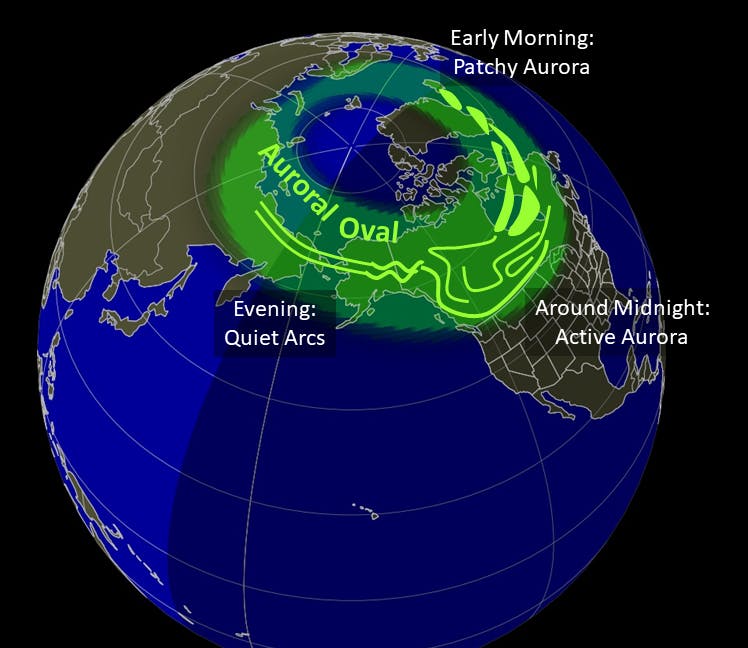What is the auroral oval and how does it work?
Northern Lights are most commonly seen under the auroral oval that surrounds the Arctic. Iceland is always under the aurora oval which means Northern Lights are in the sky almost every night.
The aurora zones

On Earth, the best places to see auroras are in the so-called aurora zones. They are two huge doughnut-shaped belts that circle the Arctic and the Antarctic, called the auroral ovals. In the north, this aurora zone includes Alaska, Canada, Greenland, Iceland, Norway, Sweden, Finland and Siberia. In the south, the auroral oval loops around Antarctica. The ovals are virtually mirror images of each other, so if Northern Lights are in the Icelandic sky, the Southern Lights are simultaneously over Antarctica.
The auroral oval forms where charged particles flow in along the magnetic field lines towards the magnetic poles of Earth. Earth’s atmosphere keeps them from penetrating lower than roughly 75 km.
The belts are usually about 500 km (300 miles) wide and 2,000 km (1200 miles) in radius measured from the magnetic poles. In quiet conditions, the ovals extend about 10 degrees in latitude between about 60° and 70° north and south latitudes. Iceland's high latitude means we are always under the auroral oval and so northern lights are seen every clear night.
During powerful magnetic storms they widen and move south (or north if you are in the southern hemisphere). This means that during evenings with high activity, an observer in Iceland sometimes has to look towards south to see northern lights.
The auroral ovals are displaced
Aurora is formed around the geomagnetic poles, which are about 10 degrees tilted from the Earth actual poles. The north geomagnetic pole is currently in the Arctic Canada, giving an extra 10 degrees gain in magnetic latitude to North American observers. The May 10th, 2024 aurora was seen in Florida Keys at 24° for this reason.
On the opposite side of Earth in Asia, it is extremely rare to see aurora from low latitudes, which are 20 degrees lower magnetically. This situation is reverse in the southern hemisphere where Tasmania and New Zealand in the eastern hemisphere are favourable places near the south geomagnetic pole and South America is in the least favourable position to see the lights.
Both ovals also extend farther towards the equator on their midnight side than on the daytime side. They are fixed, anchored in place as Earth rotates beneath. For this reason, Earth's spinning brings an observer in Iceland closest to the edge of the oval shortly before midnight, around 23:00 (11 pm). This is why the Northern Lights appear to go from east to west.
This is also when magnetic midnight occurs and the reason the Northern Lights are most commonly seen in Iceland around 11 pm. And that's the answer to one of the most common question people ask about the Northern Lights: When should I head out to see the aurora? The best answer is: Just before magnetic midnight. In Iceland, that means you have the highest chance to see aurora from 23:00-03:00. Make sure you're dressed accordingly.
How does NOAA's OVATION Prime auroral oval model work?
NOAA's OVATION Prime auroral oval model is a useful tool that gives you a rough idea of where the Northern Lights are and how intense they are likely to be about 30-90 minutes in advance. The colour codes from green to red gives the likelihood of aurora overhead. The brightness and location of the aurora is typically shown as a green oval centered on Earth’s magnetic pole. The green ovals turn red when the aurora is forecasted to be more intense.
It's important to keep in mind that this model is rather conservative and has limitations. First, it cannot predict substorms which cause intense aurora all over the sky for a few minutes. Second, it also does not show the extent from which you can see the Northern Lights. This isn't exactly a problem in Iceland, which is always under the auroral oval, but is good to know when you are further south.

